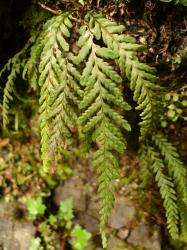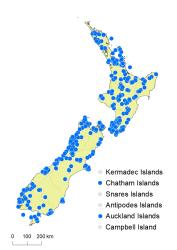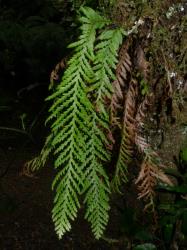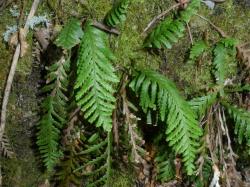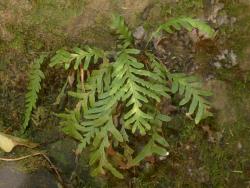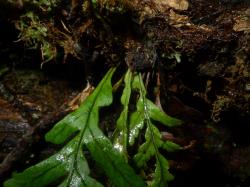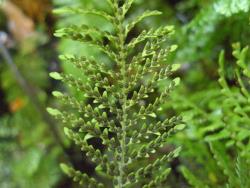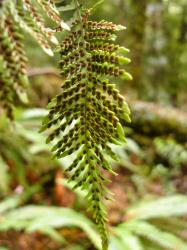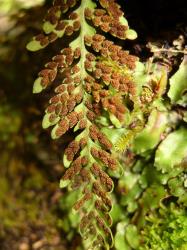- ≡ Grammitis heterophylla Labill., Nov. Holl. Pl. 2, 90, t. 239 (1807)
- ≡ Polypodium grammitidis R.Br., Prodr. Fl. Nov. Holland. 147 (1810) nom. nov. pro Grammitis heterophylla Labill. 1807 (non Polypodium heterophyllum L.)
- ≡ Gymnogramma billardierei Kaulf., Wesen Farrenkr. 81 (1827) nom. illeg., nom. nov. pro Grammitis heterophylla Labill. 1807
- ≡ Xiphopteris heterophylla (Labill.) Spreng., Syst. Veg., ed. 16, 4, 44 (1827)
- ≡ Polypodium billardierei (Kaulf.) Fée, Mém. Foug., 5. Gen. Filic. 236 (1852) nom. illeg., non Polypodium billardierei R.Br. 1810
- ≡ Grammitis grammitidis (R.Br.) Keyserl., Polyp. Herb. Bunge. 34 (1873)
- ≡ Ctenopteris grammitidis (R.Br.) J.Sm., Hist. Fil. 185 (1875)
- ≡ Ctenopteris heterophylla (Labill.) Tindale, Amer. Fern J. 41: 100 (1951)
Rhizomes erect to short-creeping, bearing scales. Rhizome scales narrowly ovate, 1.2–9.6 mm long, 0.3–1.2 mm wide, either pale brown, concolorous, and non-clathrate, or bicolorous with darker clathrate central area and pale brown non-clathrate margins. Stipes 4–50 mm long, black proximally, green distally, distinct, winged at least halfway to base, hairy. Stipe hairs sparse to abundant, white to pale red-brown, 0.2–0.4 mm long. Rachises green, winged throughout. Fronds rarely entire or usually 1–2-pinnatifid, linear to narrowly elliptic, tapering to pinnatifid segments proximally and distally in 2-pinnatifid fronds, 22–440 mm long, 3–80 mm wide, or rarely to 104 mm wide; green on both surfaces; coriaceous; curling when dry; glabrous or bearing occasional hairs 0.1–0.4 mm long, or rarely up to 1 mm long, on the margin, rachis, costa and lamina surface. Primary pinnae in 7–42 pairs below pinnatifid apex, rarely to 50 pairs in etiolated plants, not overlapping, ± oblong in 1-pinnatifid fronds, linear to narrowly elliptic in 2-pinnatifid fronds; the longest primary pinnae near mid-lamina, 3–60 mm long, or rarely to 70 mm long, 1.5–15 mm wide, or rarely to 22 mm wide, apices oblong in 1-pinnatifid fronds, acute in 2-pinnatifid fronds, margins entire or divided more than halfway to the costa into secondary segments, bases decurrent. Secondary segments decreasing in length to each end of primary pinnae; the longest 2–15 mm long, 1–2 mm wide, apices acute. Hairs simple catenate, or branched with catenate or setiform branches. Hydathodes present. Sori elliptic, elongated along veins, 1–2 mm long, in mid to upper part of lamina, lacking hairs. Sporangia 200–320 µm long; spores 37–70 µm diameter.
Notogrammitis heterophylla is usually readily distinguished by its 1–2-pinnatifid fronds. Occasionally young plants have undivided fronds, but these are recognisable by their crenulate margins. All other species of Notogrammitis in New Zealand have entire fronds.
North Island: Northland, Auckland, Volcanic Plateau, Gisborne, Taranaki, Southern North Island.
South Island: Western Nelson, Sounds-Nelson, Marlborough, Westland, Canterbury, Otago, Southland, Fiordland.
Chatham Islands, Solander Island, Stewart Island, Auckland Islands.
Altitudinal range: 0–1150 m.
Notogrammitis heterophylla has been collected in lowland, montane and subalpine areas of the North Island from Kaitāia to Wellington (and we have also seen it at Unuwhao Bush, Spirits Bay, and Whakaangi, Doubtless Bay). It occurs from about 30 m on the east coast up to 1150 m in the Ruahine Range, but is mostly found above 200 m. In the South Island it is more commonly found in coastal and lowland areas, especially west of the main divide, but reaches over 1000 m in the Cobb Valley, north-west Nelson. It also extends to the Chatham Islands, Stewart Island, and Auckland Islands.
Also Australia (Victoria, Tasmania).
Notogrammitis heterophylla is found in kauri, podocarp, broadleaved and beech forest, under mānuka and kānuka, in coastal scrub, and in subalpine scrub. It is principally an epiphytic species, often associated with a variety of forest mosses, but also grows at the base of trees, on fallen logs, on humus mounds, on rock outcrops and boulders, under overhangs, amongst scoria, on track and stream banks, on wet cliff faces, and on the ground. It has been recorded growing on Cyathea dealbata, Dicksonia squarrosa, Agathis australis, Ascarina lucida, Beilschmiedia tarairi, B. tawa, Carpodetus serratus, Coprosma chathamica, C. grandifolia, C. lucida, C. rotundifolia, Coriaria arborea, Dacrydium cupressinum, Dysoxylum spectabile, Fuchsia excorticata, Griselinia littoralis, Halocarpus kirkii, Ixerba brexioides, Knightia excelsa, Melicytus ramiflorus, Metrosideros umbellata, Myrsine australis, Neomyrtus pedunculata, Olearia avicenniifolia, O. colensoi, O. furfuracea, O. rani, Phyllocladus alpinus, Pittosporum tenuifolium, Podocarpus acutifolius, P. totara, Prumnopitys ferruginea, Pseudopanax colensoi, P. crassifolius, Pseudowintera colorata, Quintinia serrata, Schefflera digitata, Streblus heterophyllus, Weinmannia racemosa, W. sylvicola, and species of Nothofagaceae.
There is evidence for hybridisation between Notogrammitis heterophylla and N. billardierei (CHR 215640, Parris 1977), and between N. heterophylla and N. ciliata (AK 302263).
n = 37 (Brownlie 1958 – as Ctenopteris heterophylla).



